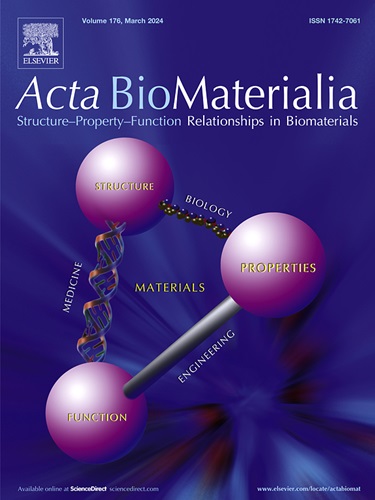Periodic mesoporous organosilica-loaded mincle agonists enhance the immunogenicity of COVID-19 subunit vaccines by dual activation of B cells and dendritic cells
IF 9.4
1区 医学
Q1 ENGINEERING, BIOMEDICAL
引用次数: 0
Abstract
Effective vaccination is crucial for intervening in the COVID-19 pandemic. However, with the continuous mutation of the SARS-CoV-2, existing vaccines including subunit vaccines cannot effectively prevent virus infections. Hence, there is an urgent need to enhance the immunogenicity of existing vaccines to induce a more potent and durable immune response. We previously found that periodic mesoporous organosilica (PMO) could act as a potential nanoadjuvant for subunit vaccines, eliciting potent antigen-specific germinal center (GC) responses by activating naïve B cells. In this study, we describe the design of PMO decorated with TDB, a potent Macrophage-induced C-type lectin (Mincle) agonist, to improve the adjuvanticity of PMO for COVID-19 vaccines. We found that the TDB@PMO adjuvant can effectively deliver antigens to lymph nodes and promote antigen uptake by immune cells. More importantly, the TDB@PMO adjuvant vaccine could activate the innate immune of both naïve B cells and dendritic cells via the Mincle signaling pathway, and further enhance the GC responses and resulting in potent SARS-CoV-2 specific humoral and cellular immune responses. Overall, we have developed an effective and safe nanoadjuvant platform, laying the foundation for the design and development of subunit vaccines against pathogens such as SARS-CoV-2.
Statement of significance
Adjuvants play a crucial role in enhancing the effectiveness of vaccines by boosting the immune response. The emergence of highly mutated viruses, such as coronaviruses, has presented new requirements for adjuvant design. This work designed a nanoadjuvant platform, TDB@PMO, to enhance the immune response of the COVID-19 subunit vaccine. The result demonstrated that TDB@PMO nanoadjuvant can simultaneously boost the activation effects of B cells and DC cells through the Mincle signaling pathway. Furthermore, immunization with TDB@PMO-RBD nanoadjuvanted vaccine in mice significantly enhanced germinal center responses and antibody production, while also eliciting a robust antigen-specific T cell immune response in spleen. This design provided a reference for the development of next-generation virus subunit vaccines.

周期性介孔负载有机硅微粒激动剂通过双重激活B细胞和树突状细胞增强COVID-19亚单位疫苗的免疫原性。
有效的疫苗接种对于干预COVID-19大流行至关重要。然而,随着SARS-CoV-2的不断变异,现有疫苗包括亚单位疫苗不能有效预防病毒感染。因此,迫切需要提高现有疫苗的免疫原性,以诱导更有效和持久的免疫反应。我们之前发现,周期性介孔有机二氧化硅(PMO)可以作为亚单位疫苗的潜在纳米佐剂,通过激活naïve B细胞引发有效的抗原特异性生发中心(GC)反应。在这项研究中,我们设计了用TDB修饰的PMO, TDB是一种强效巨噬细胞诱导的c型凝集素(Mincle)激动剂,以提高PMO对COVID-19疫苗的佐剂性。我们发现TDB@PMO佐剂可以有效地将抗原递送到淋巴结,促进免疫细胞对抗原的摄取。更重要的是,TDB@PMO佐剂疫苗可以通过Mincle信号通路激活naïve B细胞和树突状细胞的先天免疫,进一步增强GC应答,产生强效的SARS-CoV-2特异性体液和细胞免疫应答。总的来说,我们开发了一个有效、安全的纳米佐剂平台,为设计和开发针对SARS-CoV-2等病原体的亚单位疫苗奠定了基础。意义声明:佐剂通过增强免疫反应在增强疫苗有效性方面起着至关重要的作用。冠状病毒等高度变异病毒的出现,对佐剂设计提出了新的要求。本工作设计了一个纳米佐剂平台TDB@PMO,以增强COVID-19亚单位疫苗的免疫应答。结果表明TDB@PMO纳米佐剂可以通过Mincle信号通路同时增强B细胞和DC细胞的活化作用。此外,在小鼠中接种TDB@PMO-RBD纳米佐剂疫苗可显著增强生发中心反应和抗体产生,同时也在脾脏中引发强大的抗原特异性T细胞免疫反应。该设计可为下一代病毒亚单位疫苗的研制提供参考。
本文章由计算机程序翻译,如有差异,请以英文原文为准。
求助全文
约1分钟内获得全文
求助全文
来源期刊

Acta Biomaterialia
工程技术-材料科学:生物材料
CiteScore
16.80
自引率
3.10%
发文量
776
审稿时长
30 days
期刊介绍:
Acta Biomaterialia is a monthly peer-reviewed scientific journal published by Elsevier. The journal was established in January 2005. The editor-in-chief is W.R. Wagner (University of Pittsburgh). The journal covers research in biomaterials science, including the interrelationship of biomaterial structure and function from macroscale to nanoscale. Topical coverage includes biomedical and biocompatible materials.
 求助内容:
求助内容: 应助结果提醒方式:
应助结果提醒方式:


